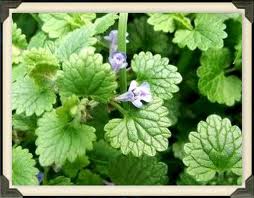Sunday, June 16, 2013
Thursday, April 11, 2013
Sunday, March 31, 2013
Ground Ivy ~ A Weed by Any Other Name
One of the first herbs I fell in love with was Ground Ivy. Yes,
it’s true. While most gardeners consider this plant a ruthless invader, the
many virtues of this mint family member will make you think twice before
plucking it.
Ground ivy is known by many
aliases: creeping Charlie, Lizzy-run-up-the-hedge, cat’s foot, alehoof,
gill-over-the-ground, creeping Jenny, haymaids…to name just a few! Eighteenth
century Swedish botanist Carolus Linnaeus cataloged this plant as glechon, Greek for “mint,” and hedera, Latin for “ivy,” but a century
later English botanist George Bentham renamed it Nepeta glechoma, or “ivy-like mint.” Several sources attribute the
name gill to a derivation of the French guiller,
meaning to ferment beer. Early Saxton invaders used the plant to flavor and
clarify beer before hops. A popular drink at the time, gill ale was believed to
impart good health to those who drank it.
Ground ivy had a strong connection with the powers of magic and
divination, as well. Considered a safeguard against sorcery, milkmaids wore ivy
when milking a newly-lactating cow to prevent spirits from enchanting the
animal. In some regions, they actually milked the cow with their arms through a
wreath of ground ivy. People also attributed ground ivy with the magical powers
to induce sleep, meditation, and healing, and promote love, friendship, and
fidelity. Ritual use of ground ivy was popular and the herb was often woven
into crowns and garlands to be worn on Midsummer’s Eve. In Scott Cunningham’s
Encyclopedia of Magical Herbs he said ~”to find out who might be using negative
magic against you, place some ground ivy around the base of a yellow candle.
Burn the candle on a Tuesday and the
person will become known to you.”
Naturalized from Europe, ground ivy now grows freely throughout the
northeast, the Midwest, and southern United States. A member of the Labiatae or
mint family, Glechoma hederacea, as
it’s now known, has the classic square stem (often covered with short, bristly,
backward-pointing hairs) of plants in the mint family. It is often
misidentified as speedwell or common mallow. A vigorous perennial with
scalloped, kidney-shaped leaves of dark green, ground ivy grows by trailing
runners, some of them as long as 39 inches. Its delicate, blue-purple,
funnel-shaped flowers bloom from March through late summer. You will find it
growing in shade or semi-shade, in wooded areas and ditches, or along
roadsides.
Throughout the centuries, ground ivy was highly regarded for it
medicinal value. Gerard recommended using it “against the humming noise and
ringing sound in the ears…and for them that are hard of hearing.” People used
the plant more effective ways, ingesting the juice for its diuretic properties
and applying it topically as an astringent. It is considered especially useful
for sinus congestion and headaches, and taken as a hot infusion for head colds.
The expressed juice, used fresh and “snuffed” up the nose prompted relief from
colds and migraine headaches, as did a snuff made from the dried powdered
leaves. Gill tea acted as an expectorant and was a popular remedy for
consumption, whooping cough, bronchial catarrh, and asthma. Now known to have a
high vitamin C content, ground ivy was useful in the prevention and treatment
of scurvy.
The ability of ground ivy to act as both a stimulant and tonic made
“gill tea” especially useful for those suffering from digestive complaints.
Acting as a blood purifier, it proved helpful for those suffering from kidney
ailments such as gravel or stones.
As a lotion or compress, ground ivy was used to cleanse sores and
ulcers. When combined with yarrow and chamomile flowers, it made a poultice for
abscesses, boils, and skin tumors. Culpepper declared it “a singular herb for
all in ward wounds, ulcerated lungs, or other parts, either by itself, or
boiled with like herbs…and being drank, in a short time, it easeth all griping
pains, windy, and choleric humours in the stomach, spleen, or belly.”
The juice of ground ivy came highly recommended as a treatment to
relieve “black eyes.” Galen physician to five Roman emperors, combined ground
ivy’s flowers with celandine and daisies, claiming that “stamped, strained, and
a little sugar and water put thereto and dropt into the eyes, takes away all
manner of inflammation…yea, although the sight were well-nigh gone.”
Gill tea was the tonic of choice for cleansing the blood and
tissues of any toxic metals, including lead poisoning, or painter’s colic as it
was known. According to Greek physician Dioscorides, “half a dram of the leaves
being drunk in four ounces and a half of fair water for 40-50 days together is
a remedy against sciatica or ache in the huckle-bone.”
Today, scientists are studying ground ivy as a potential treatment
for bronchitis, hepatitis, HIV, leukemia, and other cancers. Herbalists still
recommend it as a poultice for bruises and sore spots, and you’ll find it in
products that support lung function (some studies show it helps relax bronchial
muscles), and those that combat cough, flue, and yeast infections. High in iron
and vitamin C, it also makes a healthy addition to the diet.
In the garden, ground ivy forms an attractive ground cover that
also helps to keep the soil from eroding. While tall plants and bulbs usually
remain unscathed by the addition of this plant, shorter plants and ground
covers are no match for the spreading mint family member, so choose your
growing spot wisely, and make sure to incorporate a barrier around it. The
lovely blue flowers are attractive to bees, butterflies, and on occasion even a
hummingbird. Ground ivy also grows in less fertile areas and stays green nearly
all year long. Pluck overgrown ivy and add it to the compost pile.
Feeling adventurous? Try adding a few leaves of ground ivy to
salads or sprinkle it on some soup. To make a gill spring tonic, infuse one
ounce of ground ivy with one pint of boiling water and sweeten with honey or
sugar. When cooled, strain and drink small amounts several times a day. Try it
over ice on warm days.
While your local nursery might not offer this plant anytime soon,
ground ivy boasts a range of uses that secure it a place above the common weed.
If you do remove some of it, at least take the time to reflect on its long
history ~ it is a small herb with a tremendous determination!
Katherine Turcotte
Herb Quarterly Magazine Spring 2008
Labels:
alehoof,
Creeping Charlie,
Creeping Jenny,
gill-over-the-ground,
glechoma hederacea,
ground ivy,
herb,
lizzy-run-up-the-hedge
Tuesday, March 27, 2012
Deer Friends Come to Call
Labels:
albino deer,
deer,
nature,
White Spirit Deer
Monday, January 9, 2012
Thursday, November 24, 2011
Tuesday, October 11, 2011
Subscribe to:
Posts (Atom)







































